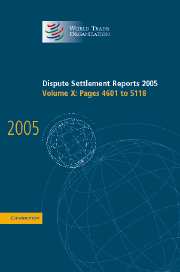European Communities – Protection of Trademarks and Geographical Indications for Agricultural Products and Foodstuffs, Complaint by Australia (WT/DS290): Report of the Panel
Published online by Cambridge University Press: 13 December 2017
Summary
INTRODUCTION
On 17 April 2003, Australia requested consultations with the European Communities pursuant to Article 4 of the Understanding on Rules and Procedures Governing the Settlement of Disputes (“DSU”), Article XXII of the General Agreement on Tariffs and Trade 1994 (“GATT 1994”), Article 64 of the Agreement on Trade-Related Aspects of Intellectual Property Rights (“TRIPS Agreement”) and Article 14 of the Agreement on Technical Barriers to Trade (“TBT Agreement”) concerning the protection of trademarks and the registration and protection of geographical indications for foodstuffs and agricultural products in the European Communities. The request was circulated to Members on 23 April 2003 in document WT/DS290/1. Consultations were held on 27 May 2003 but did not lead to a resolution of the dispute.
On 18 August 2003, Australia requested the Dispute Settlement Body (“DSB”) to establish a panel pursuant to Articles 4.7 and 6 of the DSU, Article XXIII:2 of GATT 1994, Article 64 of the TRIPS Agreement and Article 14 of the TBT Agreement. At its meeting on 2 October 2003, the DSB established a single Panel pursuant to the requests of the United States in document WT/DS174/20 and Australia in document WT/DS290/18, in accordance with Article 9 of the DSU (WT/DSB/M/156). At that meeting, the parties to the dispute also agreed that the Panel should have standard terms of reference. The terms of reference are, therefore, the following:
“To examine, in the light of the relevant provisions of the covered agreements cited by the United States in document WT/DS174/20 and Australia in document WT/DS290/18, the matter referred to the DSB by the United States and Australia in those documents, and to make such findings as will assist the DSB in making the recommendations or in giving the rulings provided for in those agreements.”
On 13 February 2004, the United States and Australia requested the Director-General to determine the composition of the Panel, pursuant to paragraph 7 of Article 8 of the DSU.
- Type
- Chapter
- Information
- Dispute Settlement Reports 2005 , pp. 4603 - 5104Publisher: Cambridge University PressPrint publication year: 2007
- 5
- Cited by



